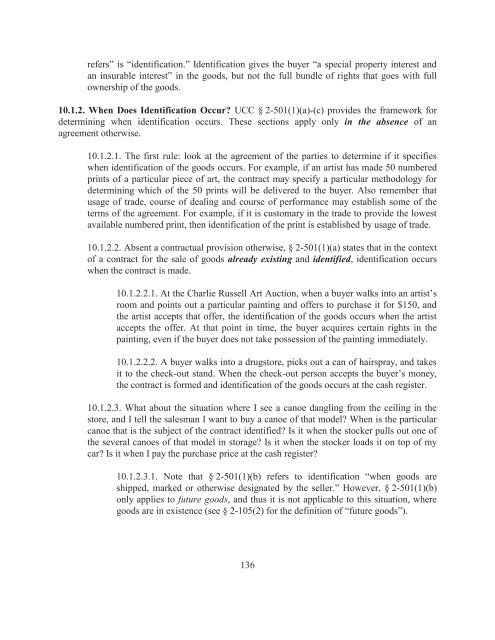Sales and Leases - A Problem-based Approach, 2016a
Sales and Leases - A Problem-based Approach, 2016a
Sales and Leases - A Problem-based Approach, 2016a
Create successful ePaper yourself
Turn your PDF publications into a flip-book with our unique Google optimized e-Paper software.
efers” is “identification.” Identification gives the buyer “a special property interest <strong>and</strong><br />
an insurable interest” in the goods, but not the full bundle of rights that goes with full<br />
ownership of the goods.<br />
10.1.2. When Does Identification Occur? UCC § 2-501(1)(a)-(c) provides the framework for<br />
determining when identification occurs. These sections apply only in the absence of an<br />
agreement otherwise.<br />
10.1.2.1. The first rule: look at the agreement of the parties to determine if it specifies<br />
when identification of the goods occurs. For example, if an artist has made 50 numbered<br />
prints of a particular piece of art, the contract may specify a particular methodology for<br />
determining which of the 50 prints will be delivered to the buyer. Also remember that<br />
usage of trade, course of dealing <strong>and</strong> course of performance may establish some of the<br />
terms of the agreement. For example, if it is customary in the trade to provide the lowest<br />
available numbered print, then identification of the print is established by usage of trade.<br />
10.1.2.2. Absent a contractual provision otherwise, § 2-501(1)(a) states that in the context<br />
of a contract for the sale of goods already existing <strong>and</strong> identified, identification occurs<br />
when the contract is made.<br />
10.1.2.2.1. At the Charlie Russell Art Auction, when a buyer walks into an artist’s<br />
room <strong>and</strong> points out a particular painting <strong>and</strong> offers to purchase it for $150, <strong>and</strong><br />
the artist accepts that offer, the identification of the goods occurs when the artist<br />
accepts the offer. At that point in time, the buyer acquires certain rights in the<br />
painting, even if the buyer does not take possession of the painting immediately.<br />
10.1.2.2.2. A buyer walks into a drugstore, picks out a can of hairspray, <strong>and</strong> takes<br />
it to the check-out st<strong>and</strong>. When the check-out person accepts the buyer’s money,<br />
the contract is formed <strong>and</strong> identification of the goods occurs at the cash register.<br />
10.1.2.3. What about the situation where I see a canoe dangling from the ceiling in the<br />
store, <strong>and</strong> I tell the salesman I want to buy a canoe of that model? When is the particular<br />
canoe that is the subject of the contract identified? Is it when the stocker pulls out one of<br />
the several canoes of that model in storage? Is it when the stocker loads it on top of my<br />
car? Is it when I pay the purchase price at the cash register?<br />
10.1.2.3.1. Note that § 2-501(1)(b) refers to identification “when goods are<br />
shipped, marked or otherwise designated by the seller.” However, § 2-501(1)(b)<br />
only applies to future goods, <strong>and</strong> thus it is not applicable to this situation, where<br />
goods are in existence (see § 2-105(2) for the definition of “future goods”).<br />
136


















